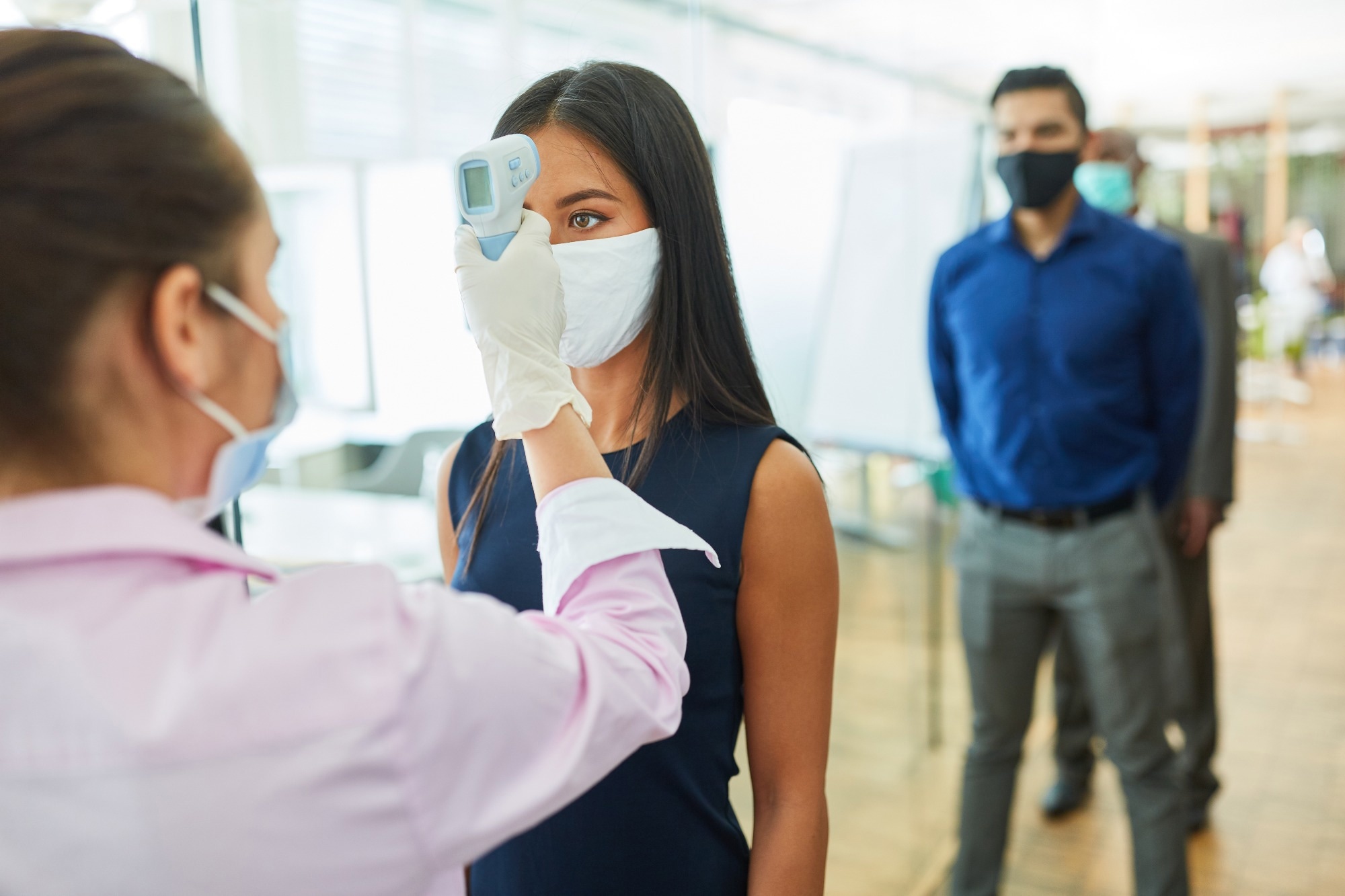Researchers explore failed SARS-CoV-2 screening at hospital entrances
In a recent study published in JAMA Internal Medicine, researchers evaluated the failure rates of coronavirus disease 2019 (COVID-19) screening at hospital entrances for visitors, health professionals, and patients at the Yale New Haven Hospital in the United States (US).

Several healthcare centers use COVID-19 screening devices at entrances to restrict the entry of patients suffering from acute SARS-CoV-2 (severe acute respiratory syndrome coronavirus 2) infections. Studies have reported failures (described as the presence of SARS-CoV-2 exposure, symptoms, or signs) in COVID-19 screening in ambulatory-type settings, especially during the initial COVID-19 wave. However, data on COVID-19 screening at in-patient healthcare facilities are limited.
About the study
In the present quality improvement-type study, researchers evaluated COVID-19 screening failures at the entry points for visitors, health professionals, and patients at the Yale New Haven Hospital, an institutional medical care center comprising 1541 beds within 2.0 campuses in Connecticut.
COVID-19 screening was performed at ten entry points of the hospital between 17 March 2020, and 8 May 2021. Failed COVID-19 screening was determined based on the elevated temperature of ≥38 °C, clinical symptoms or exposure indicating SARS-CoV-2 infections, a SARS-CoV-2-positive report in the preceding 14 days, or recent history of visiting high-risk places.
Additionally, the hospital entrance COVID-19 screeners assessed face-mask use, and masks were provided to individuals who did not wear marks or used unacceptable covering for protection, such as bandanas or cloth masks. Data were also obtained on COVID-19 incidence in Connecticut. High covid-19 incidence and low COVID-19 incidence were described as >10 cases or <10 cases among every 100,000 persons, respectively, on average, in one month.
Results
In total, 951,033 individuals were screened for COVID-19 at the hospital entrances, and for 631 individuals (0.1%), screening failed, summing up to 0.7 COVID-19 cases among every 1,000 screened individuals. Screening failure rates varied considerably, with a peak during March 2020 (2.6% failed COVID-19 screenings, 26 screening failures among every 1,000 screened individuals) before a declining trend observed during the following months.
During the initial COVID-19 wave (between March and May 2020), screening failed for 0.7% of individuals (6.9 screening failures among every 1,000 individuals screened). During the subsequent waves, consistent failure rates of COVID-19 screening were observed during the periods of high COVID-19 incidence (between October 2020 and April 2021, 0.4 screening failures among every 1,000 screened individuals) and low COVID-19 incidence (between June to September 2020 and May 2021, 0.3 screening failures among every 1,000 screened individuals) in community-based settings.
In total, 62,009 visitors and patients (seven percent of entrance individuals) and 7,742 health professionals were provided masks because of incorrect or no face-mark wearing. Considering the benefits of masking and the need to control asymptomatic infections, the service represented an added value of screening in COVID-19 mitigation.
In total, 30 full-time staff were needed for 24-hour COVID-19 screening at the hospital entrances, equating to a value of 1,288,560 US dollars of yearly compensation (based on the minimum remuneration of 15 US dollars/hour for Connecticut) and benefits (estimated to be 40%). The estimate was exclusive of manager-level workers, supplies such as masks and gloves, and devices such as thermometers. Thus, the least cost of identifying one COVID-19 screening failure was equated to 224 US dollars during the initial pandemic and 2351 US dollars throughout the study period.
In 2020, the total number of individuals screened at the hospital during March, April, May, June, July, August, September, October, November, and December were 5,303 individuals, 16,521 individuals, 22,546 individuals, 50,362 individuals, 76,559 individuals, 80,479 individuals, 94,997 individuals, 99,638 individuals, 74,016 individuals, and 65,196 individuals, respectively. The number of persons for whom screening failed in the corresponding months was 140 individuals, 125 individuals, 43 individuals, 50 individuals, 18 individuals, 23 individuals, 30 individuals, 80 individuals, 27 individuals, and 38 individuals, respectively.
In 2021, in January, February, March, April, and May, 63,501 individuals, 62,198 individuals, 92,884 individuals, 98,178 individuals, and 48,655 individuals. The corresponding number of individuals who failed screening were 60 (0.1%), 10 (0.02%), four (below 0.01%), three (below 0.01%), and zero (0.0%), respectively.
According to community incidence entrance screening at Yale New Haven hospital during the first wave, the number of individuals who turned away, were screened, and turned away per 1000 screened, were 308 individuals, 44,370 individuals, and 6.9 individuals, respectively. During the period of low incidence, the corresponding numbers were 121 individuals, 351,052 individuals, and 0.3 individuals, respectively. During the period of high incidence, the corresponding number of individuals were 202 individuals, 555,611 individuals, and 0.4 individuals, respectively. In total, 631 individuals were turned away, 951,033 individuals were screened, and 0.7 individuals had turned away among every 1,000 individuals screened.
Screening failure rates were considerably higher during the initial pandemic period, probably due to stronger adherence to COVID-19 screening protocols and better vigilance toward SARS-CoV-2 exposure and the development of COVID-19 symptoms. Moreover, educational awareness and communication may have reduced limited outdoor movement or those with exposure or symptoms.
Overall, the study findings showed a small benefit in maintaining COVID-19 screening at hospital entrances concerning SARS-CoV-2 exposure, COVID-19 symptoms, or history of travel to high-risk places. Of the nearly 1.0 million individuals screened, entrance screening failed for <0.1% of individuals. However, studies determining the true incidence of COVID-19 among screened individuals are required to evaluate COVID-19 screening efficacy.
- Scott C. Roberts, MD, MS et al. (2022). Analysis of Failure Rates for COVID-19 Entrance Screening at a US Academic Medical Center. JAMA Internal Medicine. doi: 10.1001/jamainternmed.2022.5426 https://jamanetwork.com/journals/jamainternalmedicine/fullarticle/2798551
Posted in: Medical Science News | Medical Research News | Disease/Infection News
Tags: Coronavirus, Coronavirus Disease COVID-19, covid-19, Efficacy, Healthcare, Hospital, Medicine, Pandemic, Respiratory, SARS, SARS-CoV-2, Severe Acute Respiratory, Severe Acute Respiratory Syndrome, Syndrome

Written by
Pooja Toshniwal Paharia
Dr. based clinical-radiological diagnosis and management of oral lesions and conditions and associated maxillofacial disorders.
Source: Read Full Article
